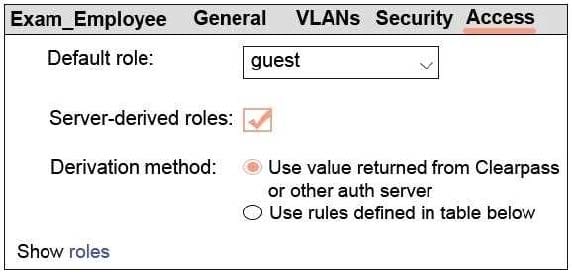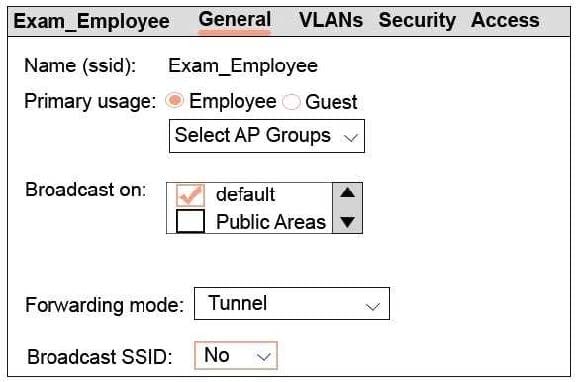Exam Details
Exam Code
:HPE6-A70Exam Name
:Aruba Certified Mobility AssociateCertification
:HP CertificationsVendor
:HPTotal Questions
:131 Q&AsLast Updated
:Mar 27, 2025
HP HP Certifications HPE6-A70 Questions & Answers
-
Question 91:
A company has an Aruba Mobility Master (MM)-based solution that runs ArubaOS 8 and uses the default AirMatch and Client Match settings. The ARM profile has been disabled for 5GHz radios. How are channel and transmit power settings managed for these radios?
A. with legacy ARM
B. with Rule Based Client Match
C. with legacy Client Match
D. with AirMatch
-
Question 92:
A company plans to deploy a Mobility Master (MM). The MM will manage 50 Mobility Controller (MC) appliances that will control a total of 700 APs, and 10 Virtual Mobility Controllers (VMCs) that will control a total of 200 APs.
How many MM licenses does the company require?
A. 60
B. 210
C. 900
D. 960
-
Question 93:
A company has an Aruba solution and wants to provide guests with wireless access. The company wants to assign guests IP addresses in subnets that exist only within the Aruba solution. Which feature should network administrators set up so guests can send traffic on the Internet without changes to the company routing solution?
A. Enable NAT on the VLAN assigned to the guest WLAN.
B. Set up a dynamic default gateway on the Mobility Controllers (MCs).
C. Create destination NAT rules for the guest role.
D. Enable policy-based routing for the guest traffic.
-
Question 94:
How does a high-gain omni-directional antenna compare to a typical omni-directional antenna?
A. it provides more multi-user spatial streams.
B. it provides more coverage in the horizontal direction than in the vertical direction.
C. it provides more single-user spatial streams.
D. it provides more coverage in both the horizontal and vertical directions.
-
Question 95:
A network administrator creates an employee WLAN on an Aruba solution that uses WLAN WPA2Enterprise security and an external RADIUS server. When the administrator tests the WLAN, the test client receives limited connectivity and cannot access any resources, but the RADIUS server shows that the user authenticated successfully. What should the administrator check as a possible source of this issue?
A. the connectivity between the AP that the client is associated to and the MC
B. the firewall role and policy that apply to this user
C. the certificate on the RADIUS server
D. the connectivity between the Master Controller (MC) for the client and the RADIUS server
-
Question 96:
A company has an Aruba Mobility Master (MM)-based solution. Where can network administrators look to monitor the health status of all controllers, APs, and clients?
A. the top banner
B. the MM Maintenance pages
C. the Performance dashboard
D. the Potential Issues dashboard
-
Question 97:
Which settings can a Mobility Master (MM) deploy to Mobility Controllers (MCs) but master controllers CANNOT deploy to local controllers?
A. radio profiles
B. WLAN settings
C. Interface settings
D. AAA profiles
-
Question 98:
Refer to the exhibit.

A network administrator sets up the Exam_Employees WLAN on an Aruba solution with a default role of guest, as shown in the exhibit. To which users does the guest role apply?
A. users who successfully authenticate and are assigned to the default role by the RADIUS server
B. users who successfully authenticate and are not assigned a different role by the RADIUS server
C. users who have connected to the SSID, but have not yet attempted authentication
D. users who fail authentication
-
Question 99:
Assume that administrators accept the default forwarding mode for WLANs. How does wireless user traffic flow in a master-local architecture, and how does it flow in a Mobility Master (MM) architecture?
A. In the master-local architecture, all traffic is tunneled to the master controller to handle. In a MM architecture, all traffic is tunneled to the MM to handle.
B. In both architectures, APs forward corporate user traffic locally and tunnel guest user traffic to a Mobility Controller (MC) to handle.
C. In both architectures, traffic is tunneled to a Mobility Controller (MC) to handle.
D. In the master-local architecture, traffic is tunneled to a local Mobility Controller (MC) to handle. In a MM architecture, all traffic is tunneled to the MM to handle.
-
Question 100:
Refer to the exhibit.

What describes the behavior for this WLAN?
A. APs in the default group broadcast the SSID. Clients can connect to the WLAN on APs in the default group only.
B. No APs broadcast the SSID. Clients cannot connect to the WLAN until administrators activate it.
C. No APs broadcast the SSID. Clients can connect to the WLAN on APs in the default group only.
D. APs in the default group broadcast the SSID. Clients can connect to the WLAN on APs in any group.
Related Exams:
HP0-D15
Administering HP CloudSystem Matrix SolutionsHP0-D20
Architecting the HP Matrix Operating EnvironmentHP2-E56
Selling HP SMB SolutionsHP2-H88
Selling HP Business Personal Systems Hardware 2019HP2-I14
Selling HP Supplies 2020HP2-I15
Selling HP Business Personal Systems Hardware 2020HP2-I17
Selling HP Printing Hardware 2020HP2-I44
Selling HP Workstations 2022HP2-I73
Selling HP Retail and Hospitality Solutions 2024HP2-N51
HP Application Lifecycle Management 12.x Software
Tips on How to Prepare for the Exams
Nowadays, the certification exams become more and more important and required by more and more enterprises when applying for a job. But how to prepare for the exam effectively? How to prepare for the exam in a short time with less efforts? How to get a ideal result and how to find the most reliable resources? Here on Vcedump.com, you will find all the answers. Vcedump.com provide not only HP exam questions, answers and explanations but also complete assistance on your exam preparation and certification application. If you are confused on your HPE6-A70 exam preparations and HP certification application, do not hesitate to visit our Vcedump.com to find your solutions here.